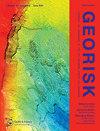System reliability and sensitivity analysis of lateral loaded pile considering soil’s spatial variability
IF 4.8
3区 工程技术
Q1 ENGINEERING, GEOLOGICAL
Georisk-Assessment and Management of Risk for Engineered Systems and Geohazards
Pub Date : 2023-02-19
DOI:10.1080/17499518.2023.2174264
引用次数: 0
Abstract
ABSTRACT Probabilistic analysis has been widely used to assess the inherent uncertainty of variables in laterally loaded pile systems, but the calculation is still difficult and time-consuming. The present study presents an efficient probabilistic analysis framework for a laterally loaded pile system. The performance of the system is defined as the lateral deflection at the pile head and maximum bending moment of the pile shaft, corresponding to two failure modes. Within this framework, the spatial variability of the soil and the correlation between failure modes are considered by the random field theory and the First-Order Reliability Method, respectively. Moreover, the Sequential Compounding Method is used as an efficient tool to determine the system reliability indexes. The framework is confirmed by comparing the reliability indexes of failure modes and systems with those of the Monte Carlo Simulation Method. Furthermore, a parametric analysis and system sensitivity analysis are performed. The results show that the auto-correlation distance, allowable lateral displacement at the pile head, and allowable bending moment of the pile shaft have a great influence on reliability indexes of failure modes and system, and the major parameter of soil in affecting pile is the elastic modulus compared with the undrained shear strength.考虑土体空间变异性的侧向荷载桩系统可靠性和灵敏度分析
本文章由计算机程序翻译,如有差异,请以英文原文为准。
求助全文
约1分钟内获得全文
求助全文
来源期刊
CiteScore
8.70
自引率
10.40%
发文量
31
期刊介绍:
Georisk covers many diversified but interlinked areas of active research and practice, such as geohazards (earthquakes, landslides, avalanches, rockfalls, tsunamis, etc.), safety of engineered systems (dams, buildings, offshore structures, lifelines, etc.), environmental risk, seismic risk, reliability-based design and code calibration, geostatistics, decision analyses, structural reliability, maintenance and life cycle performance, risk and vulnerability, hazard mapping, loss assessment (economic, social, environmental, etc.), GIS databases, remote sensing, and many other related disciplines. The underlying theme is that uncertainties associated with geomaterials (soils, rocks), geologic processes, and possible subsequent treatments, are usually large and complex and these uncertainties play an indispensable role in the risk assessment and management of engineered and natural systems. Significant theoretical and practical challenges remain on quantifying these uncertainties and developing defensible risk management methodologies that are acceptable to decision makers and stakeholders. Many opportunities to leverage on the rapid advancement in Bayesian analysis, machine learning, artificial intelligence, and other data-driven methods also exist, which can greatly enhance our decision-making abilities. The basic goal of this international peer-reviewed journal is to provide a multi-disciplinary scientific forum for cross fertilization of ideas between interested parties working on various aspects of georisk to advance the state-of-the-art and the state-of-the-practice.

 求助内容:
求助内容: 应助结果提醒方式:
应助结果提醒方式:


